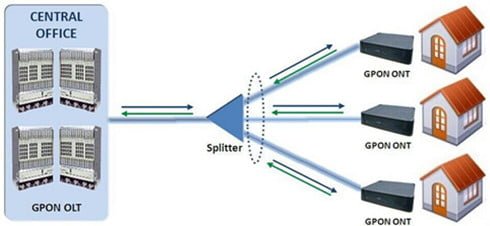FTTH Access Network Based on GPON
The increasing demands for new data transmission services and various bandwidth-related applications have led telecommunication operators to seriously consider optical fiber based networks. Enabling faster computer connectivity, fiber to the home (FTTH) seems to be an ideal choice to meet those demands in the long run.
FTTH, a form of fiber-optic communication delivery, refers to the installation and use of optical fiber from a central point directly to individual buildings. In FTTH network, fiber reaches the boundary of the living space, like a box on the outside wall of a home. FTTH network makes low attenuation and great bandwidth over single-mode fibers possible. There are two main technical approaches for FTTH network: active optical network (AON) and passive optical network (PON). This post mainly talks about FTTH access network based on Gigabit passive optical network (GPON) which is a form of PON.Introduction to GPON-Based FTTH Access Network
GPON is defined by ITU-T recommendation series G.984.1 through G.984.6. It is built on a series of technology enhancements that extend and improve on earlier forms of PON. Like its predecessors, GPON is a point-to-multipoint technology in which a single optical port (optical line terminal, OLT) communicates with multiple subscriber devices (optical network terminal, ONT) over common optical fiber by means of an optical splitter. In GPON-based FTTH access network, the unpowered optical splitters are used to enable a single optical fiber to serve multiple premises, typically 64-128.Components of GPON-Based FTTH Access Network
There are three main components in GPON-based FTTH access network: a central office node, called an OLT, one or more user nodes, called optical network units (ONUs) or ONTs, and optical splitters. An OLT is usually placed in the Local Exchange and it’s the engine that drives FTTH system. The important functions of an OLT are traffic scheduling, buffer control and bandwidth allocation. ONTs are deployed at customer’s premises. They are connected to the OLT by means of optical fiber and no active elements are present in the link. An optical splitter, also called PON splitter, is used to split the power of the signal. Usually, an optical splitter is able to widen operating wavelength range and support network survivability and protection policy. The following image shows the GPON design.

Why Choose GPON for FTTH Access Network?
GPON is chosen for FTTH access network because of its following features and advantages.
- Since GPON takes advantages of optical wavelength division multiplexing (WDM), a single fiber can be used for both upstream and downstream data transmission. Upstream data transmits on a wavelength of 1310nm with a speed up to 1.25 Gbps. Downstream data transmits on a wavelength of 1490nm with a speed up to 2.5 Gbps. Thus, great bandwidth is delivered by GPON. Besides, fiber split ratios in GPON network can sometimes reach up to 1:128. That is to say the above-mentioned great bandwidth can be delivered to potential 128 subscribers.
- More importantly, the cost related to the maintenance of PON system may be low, as there is little chance that the passive parts deployed in GPON infrastructure will broke down or go wrong during their operation. Besides, the GPON design is a tree topology in order to maximize their coverage with minimum network splits, thus reducing optical power.
FTTH network based on GPON can provide cost-effective solutions for the future bandwidth demands, such as TV and video services, online games and VoIP (Voice over Internet Protocol). FOCC’s GPON ONTs, OLTs and optical splitters are all of high quality with high-performance. You can visit FOCC for more information about GPON FTTH solutions
